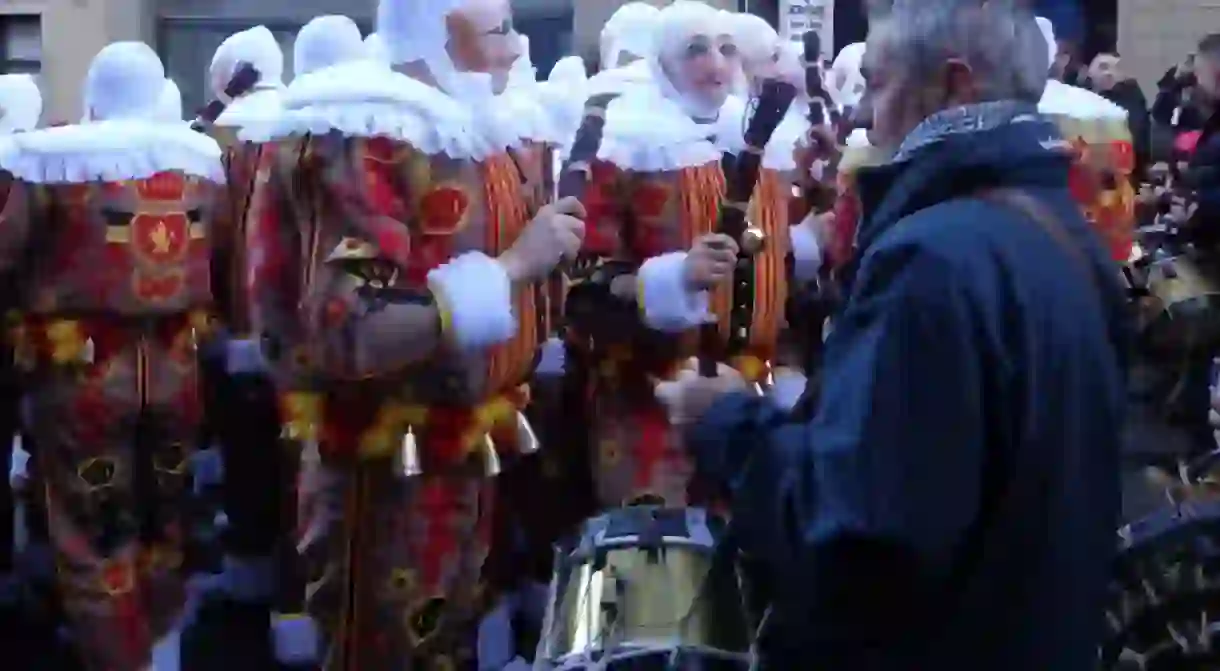Why Is The Carnival Of Binche Celebrated In Belgium?

The Carnival of Binche in Belgium is one of the most famous celebrations in Belgium, usually taking place in February. Due to its originality and long tradition, this festival was designated as a ‘Masterpiece of the Oral and Intangible Heritage of Humanity’ by UNESCO in 2003. Read on to find out more about why this unique carnival exists.
Did you know – Culture Trip now does bookable, small-group trips? Pick from authentic, immersive Epic Trips, compact and action-packed Mini Trips and sparkling, expansive Sailing Trips.
The origins of the Binche festival are actually still uncertain. According to the tradition, the festival may be related to a parade organized by Mary of Hungary for her brother Charles Quint in 1549. She lived in a castle in the city center, which you can still see the remnants of by the Saint Ursmer Collegiate Church. During that original parade, people were probably wearing colorful costumes which would later become the origins of the modern Gilles’ clothes. Gilles, grouped in societies, are the main characters of the present carnival.
In any case, the Binche festival is closely related to Catholic Easter celebrations. Catholics are supposed to fast during the 40 days before Easter, the first day of this period being the Ash Wednesday. The seven days before are called gras, or ‘shrove’ in English, because people are indulging a bit before the Lent period begins. The most important of the Shrove days is Tuesday.
The carnival celebrations are so important that Belgium will spend all year preparing for them. The societies organize soumonces during the six Sundays before the Shrove Sunday to make sure drummers and musicians are ready. Men are proud to be Gilles and they spend a lot of money to respect the traditions. Women also play an important role as they accompany the Gilles and oversee the organization of the festivities. You can recognize those women by the funny decorated hats they wear, that are different from one year to the other.
On Shrove Sunday, the celebration begins. The future Gilles, Peasants, Pierrots and Harlequins get up early to put on their costumes and walk around the city center, accompanied by drums or viola. Each society wears costumes that are related to the same theme. The costumes have been prepared in secret for many months and are mostly inspired by current affairs, movie characters, political events or other cultures. Last year, you could have met groups of Stromae, Minions, Belgium football supporters, people from Brittany, etc. You can view the detailed costumes during the afternoon procession and/or during the late evening parties.

Shrove Monday is dedicated to Binche Youth. There are three associations of youth in Binche: the Catholic Youth, the Liberal Youth and the Socialist Youth. From 10am onwards, they walk from café to café with the viola. At 11am, don’t miss the huge confetti battle in each bar in the city center! In the afternoon, the future Gilles are normally resting at home. However, you might see some of them drinking Belgian beer around the main square, and at the same moment, costumed children are making the friendship rondeau. Around 7pm, join the Youth near the train station to admire the fireworks display under the sound of drums and the red light of bengal fires.
After two days of music and fancy costumes, Binche people are ready for the most important and traditional day of the Carnival: Shrove Tuesday, or Mardi Gras. Almost everyone in Binche gets up before 4am to make the characters of the day come alive. Children become Pierrots, Harlequins or little Gilles, and the older boys wear peasants clothes.
This is the only day in the year when you can see Gilles in Binche. Gilles are only men from Binche, and they are able to become Gilles when they are just three years old. They wear colorful clothes, wooden sabots, a white bonnet, and carry the apertintaille, a special kind of bell. They also put straw on their costume in order to look bigger, and traditionally, Gilles can’t walk without a drum. This is one of the most special moments of the day — walking around in the dark, listening to the ‘Aubade matinale’. A special breakfast is eaten at 7am, usually consisting of Champagne and oysters. Then, all societies dance in the streets leading to the main square. Gilles, wearing their wax masks, hold a ramon to mark rhythm and clap their sabots on the cobblestones to get rid of the winter chill.

On the main square, the Gilles and the other children societies are invited by the mayor to the city hall. Some of them receive medals for special service. At 3pm, the procession starts, during which every character parades and throws oranges. Try to catch one, as it will bring you luck for the year! The Gilles are gorgeous with their hat made from ostrich feathers, but you will only see them if it’s not raining.
Around 8pm, every character forms a huge rondeau on the main square while musicians play carnival songs. Bengal lights create a special atmosphere, and the dancing shadows are reflected on the houses and the beautiful city hall. This is one of the most emotional moments of the carnival because it means the end of festivities. The Carnival ends with beautiful fireworks, finally lighting the words Plus Oultre, Charles Quint’s motto.
Binche festival is the opportunity to discover one of Belgium‘s most famous traditions – a unique folklore. Tourists are coming from all over the world to see its traditional festivities. For Binche people, taking part in the carnival, dancing and having fun together during three days is a family tradition they could never miss. If you want to discover Belgium culture, you definitely have to see this. Prepare yourself for music, champagne, oysters and the very best of Belgium folklore.














